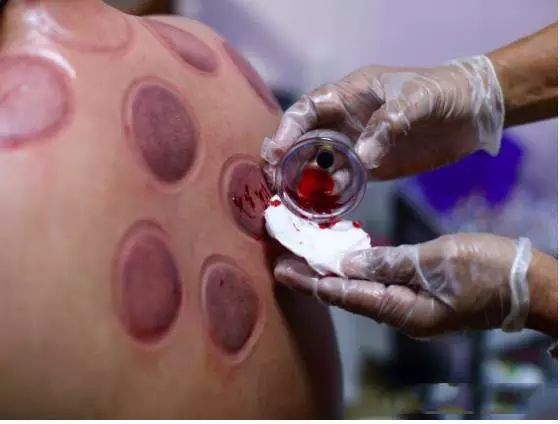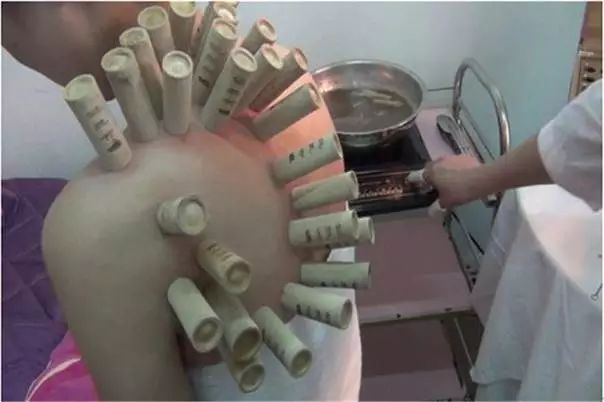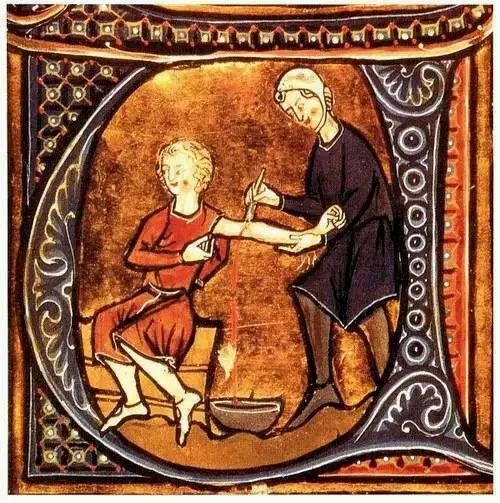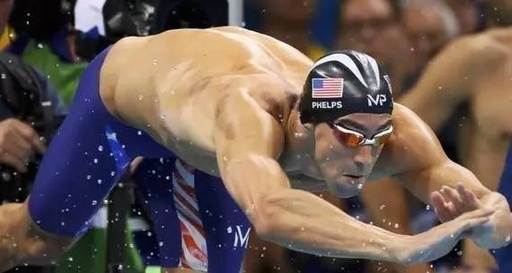
Phelps wins gold in the 200m butterfly final
On the fourth day of the Olympics, 31-year-old swimming veteran Phelps won two gold medals within an hour, bringing his total Olympic gold medal count to 21.
While focusing on his brilliant achievements, some media and netizens noticed the circular marks on Phelps’ shoulders, which are the “marks” left after his cupping therapy.
Media reports indicate that Phelps has been using this method for therapy for some time. Besides him, American gymnast Alex Naddour, men’s gymnastics team captain Sam Mikulak, and former swimmer Natalie Coughlin are also very fond of cupping. Naddour stated that this therapy helps relieve his pain, saying, “It’s a secret I’ve been using this year that has kept me healthy, and it’s worth more than any money I’ve spent on anything else.”
“Cupping” is a well-known medical method in China, used for promoting qi and blood circulation, reducing swelling and pain, dispelling wind and cold, and unblocking meridians. Many consider this a victory for Traditional Chinese Medicine (TCM), as TCM culture is being promoted abroad through the Olympics. But is this really the case?

Cupping therapy originates from the human instinct of “sucking”
Cupping is a medical technique that utilizes negative air pressure. “Using negative pressure” is a skill we are born with, stemming from the “sucking” instinct present since infancy.
In Jin Yong’s novel, “The Return of the Condor Heroes,” Yang Guo sucks out the poison from the Ice Soul Silver Needle to save the Wu brothers. Although he was already poisoned by the love flower, the two poisons counteracted each other, allowing him to survive. In contrast, Cheng Lingsu from “The Flying Fox of Snowy Mountain” was not so lucky; she was the master of the most powerful and terrifying poison, the Seven-Heart Begonia, but died trying to save Hu Fei by sucking out the poison.
Jin Yong’s martial arts novels design these plots to express the emotions and loyalties between characters, as seen in numerous ancient texts where ministers suck out poison for their kings, children for their parents, and generals for their soldiers. This also indicates that using negative pressure for healing is a skill many people can learn without formal training. Even today, many still use this method in emergencies when bitten by insects or snakes.
However, relying on one’s mouth to suck out air is quite inconvenient, occasionally unseemly, and somewhat unhygienic. Thus, various cultures around the world have developed techniques and tools, leading to the emergence of specialized medical instruments such as gourds, bamboo tubes, cow horns, ceramic jars, and glass cups. The cupping referred to in China is known as “cup suction” in the West, which is a more accurate term than “fire cupping.”

After the reform and opening up, cupping therapy in TCM developed vigorously
The earliest record of cupping therapy in China can be found in the “Fifty-Two Diseases Formula” unearthed from the Mawangdui site in Changsha, dating back to the Spring and Autumn period and the Warring States period, which mentions “using horns.” Hence, later generations referred to this method as “horn therapy.” During the Eastern Jin dynasty, Ge Hong and Tao Hongjing also mentioned the “needle and horn” treatment, which is the prototype of modern needle cupping therapy and prick blood cupping therapy.
In ancient China, glass products were not well developed, and the medical instruments evolved from animal horns to ceramic bottles and jars over a long period. For a significant historical period, bamboo tubes were the primary vessels, heated by boiling water to expel air, hence also called “water horns.” Bamboo cupping was popular during the Sui and Tang dynasties and completely replaced animal horns by the Song, Jin, and Yuan dynasties. Its application evolved from simple boiling to “medicated tube therapy,” where various herbs were boiled in bamboo tubes to enhance efficacy.
By the Ming dynasty, cupping had become a mature clinical medical technique, with some innovations and developments. The imperial physician Fang Xian mentioned in “Remarkable Effective Formulas” that “to treat drowning, use a wine jar, a handful of paper money, burn it in the jar, and quickly cover the jar’s mouth over the person’s navel; if cold, burn more paper money and place it in the jar to revive the person.” By the Qing dynasty, the use of clay jars, with the method of burning to consume air, became established and popularized, which is what later generations referred to as “fire cupping.”
In the late Qing and early Republic of China, cupping therapy fell into disuse among the populace and was essentially stagnant. After 1949, the state began to emphasize the exploration and organization of folk therapies, and cupping therapy, which had scattered among the people, was once again valued and developed, especially after the reform and opening up, when various health centers sprang up, making cupping well-known among the public and an important therapy in TCM. However, this does not mean that cupping is an original creation of TCM.

Cupping is not unique to TCM; it is not uncommon worldwide
In fact, cupping has developed to varying degrees in different civilizations around the world, each with its own characteristics.
Ancient Greeks and Romans preferred to use metal cups as heating vessels, and glass cups were widely used from the 17th to 19th centuries. In the 19th century, cow horn cups began to be used, and new types of vessels combining syringes and suction cups emerged, while such vessels appeared in China only a few decades later. In ancient Greece, there are relief sculptures in the temple of Asclepius depicting two medical suction cups. In Homer’s epic, “The Iliad,” around the early 12th century BC, the Greek coalition crossed the sea to invade Troy, and the army physician Podalirius used the cup suction method to perform bloodletting on Princess Chryseis.
Early Indian medical classics, such as the “Sushruta Samhita” (compiled no later than the 2nd century AD), record over a hundred surgical instruments. Among them, three bloodletting methods are mentioned: leeches, horns, and gourds. The horn method is roughly similar to that of TCM, while the gourd method involves placing a lamp inside the gourd to create suction.
Whether it is the ancient Greek medical suction cup or the ancient Indian gourd, both are closer to the modern popular cupping therapy than China’s “horn method.”
In the negative pressure therapies of India and Europe, there is also the less common method of “leech suction” used to draw blood from the body. The Indian “Charaka Samhita” mentions, “Among the auxiliary surgical instruments, leeches are the best.” Ancient Egyptian physician Nicander mentioned the detoxifying function of leeches in his medical education poetry for treating bites from poisonous animals or other poisoning phenomena.

Western medicine’s obsession with cupping therapy once surpassed that of TCM
In ancient China, cupping was widely practiced in folk medicine, but there are few records in medical texts. In contrast, cupping was extremely popular in Western medicine historically, even reaching a frenzied level. In 1801, the famous British cupping practitioner Thomas Meapleson detailed various diseases suitable for cupping in his book “On the Art of Cupping,” including stroke, angina, asthma, hemoptysis, cough, epilepsy, pneumonia, poisoning, paralysis, rheumatism, and more, claiming it could treat almost all ailments.
Western traditional medicine, inherited from ancient Greece and Rome, highly praised bloodletting therapy. From Hippocrates to Galen to Avicenna, there are countless legends and records of ordinary people using cupping for beauty, from European noblewomen to George Washington, the father of the United States, who was treated with bloodletting.
Cup suction is a method of bloodletting therapy, enjoying a high reputation and widespread application as an “old habit.”
However, bloodletting therapy began to face skepticism, especially after George Washington died from bloodletting, shaking the long-held belief for over 2000 years. In the early 19th century, Scottish army physician Alexander Hamilton divided 366 sick soldiers into three groups: one group received traditional bloodletting therapy, while the other two groups did not. The results showed that the two groups that did not undergo bloodletting had 2 and 4 deaths, while the bloodletting group had 35 deaths.
Increasing medical experiments demonstrated that bloodletting therapy significantly increased patient mortality. With the advancement of medicine, microbiologists like Pasteur and Koch identified the true causes of major infectious diseases, leading to the demise of the humoral theory that bloodletting relied on, thus exiting the historical stage. Consequently, bloodletting therapy and the cupping therapy that was part of it naturally followed suit.

References: Liao Yuqun, “A Comparative Study of ‘Cup Suction’ and ‘Leech Suction’ in China and the West”

